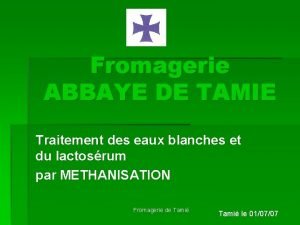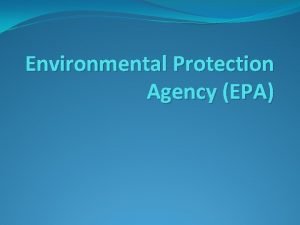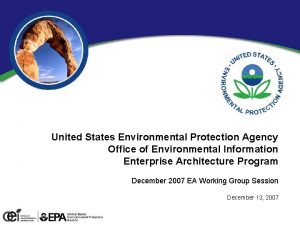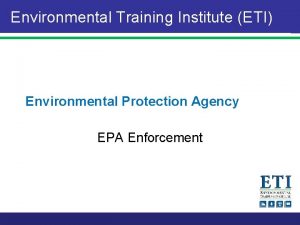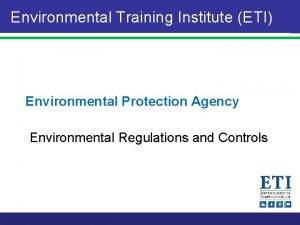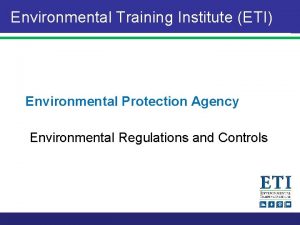Effluents Standards In Pakistan Environmental protection agency EPA





- Slides: 5

Effluents Standards • In Pakistan Environmental protection agency (EPA) is responsible for all aspects of the environment; regulation of sanitation and wastewater management activities as just one of their duties. National Environmental Protection body have set national environmental quality standards (NEQS), which in turn are the responsibility of Govt. to enforce it. . Water quality and treatment standards usually come in one of three forms: • Technological standards which specify that the treatment must include certain technologies or processes. Frequently this standard is expressed in the form as "secondary or biological treatment” is required without identifying either the water quality of the effluent to be produced, or the exact details of the technical process to be used. • Effluent standards are specifications of the physical, biological, and/or chemical quality of effluent to be produced by the treatment. These usually include allowable concentrations of (BO, COD), Suspended Solids (SS), Nitrogen, Phosphorus, etc. Most such concentrations are expressed in mg/L. • Uniform Effluent Standards are the most common, in which target concentrations of pollutants in the effluent are standardized across the entire country or state. This approach has the advantage of simplicity, ease of implementation, and the appearance of “fairness” to all who have to meet them. Unfortunately, they are usually inefficient, leading to excessive treatment in some cases, and insufficient treatment in others.

Effluents standards • Ambient or Stream Quality Standards: Where the receiving water is used for drinking, bathing, fishing or reuse, the standards for the receiving water are relatively high. If however natural processes of dilution and biodegradation can improve the quality sufficiently before there is significant use of the resource, then the stream standards can be lower. Under this system, rivers or streams are put into categories such as Class 1, Class 2 etc. • Once the desired stream quality is known, then to determine the maximum concentrations of each pollutant to be allowed in each wastewater discharge; These concentrations become the standards for that discharge. Under this arrangement, different discharges in different environmental contexts must meet different effluent standards. Ambient standards have the advantage that they ensure resources are efficiently allocated to address local environmental conditions. The major disadvantages are that the approach requires considerable planning. It can also be open to political and legal challenges, as different actors ask ”Why should they be allowed to discharge more pollution than me? ” If soundly developed and enforced, however, ambient standards offer a far more efficient and cost-effective approach to improving the environment. Where rigorous water quality modeling is not possible or practical, the establishment of watershed or river basin management boards can still help to prioritize investment in treatment in a systematic fashion. It makes little sense to invest large amounts of money in wastewater treatment for a single city if pollution from other cities or from agricultural runoff will nullify any beneficial impact. It will usually make sense to concentrate efforts where they can make a difference. The comparative advantage of a watershed management board is not necessarily its technical capacity, but its perspective; the board is responsible for looking at the appropriate use of water across the watershed.



Municipal and Industrial Wastewater Treatment Municipal Wastewater treatment consists of four major categories. (i) Pretreatment (ii) Primary treatment (iii) Secondary treatment and (iv) Advanced treatment. The purpose of pretreatment is to protect the wastewater treatment plant (WWTP) equipment. Primary treatment removes those pollutants that are either settle or float. It remove 50% of suspended solids and 35% BOD. Secondary treatment remove upto 85% suspended solids and BOD. It does not remove nitrogen, phosphorus, or heavy metals significantly, nor completely remove pathogenic bacteria and viruses. When secondary process is not sufficient to fulfilled the treatment requirement then advanced (tertiary) treatment has to be done. It remove 99% BOD, Phosphorus, suspended solids, and bacteria, 95% of nitrogen. It produce clean, colorless odorless water. The impurities removed from wastewater do not vanish simply. Some of the organics are broken down into harmless CO 2 and water. Most of the impurities are removed from wastewater as a solid, that is sludge. Sludge handling and disposal must also be carried out to achieve satisfactory pollution control. Industrial Wastewater: The municipal WWTP are usually not designed to remove the impurities of industrial waste. The industrial waste can damage the sewer system and /or treatment units. Therefore, a pretreatment process for industrial waste is essential before disposing it in to sanitary sewer and treatment units. The objectives of pretreatment are (i) Prevention of pollutants that interfere the operation of WWTP. (ii) To prevent WWTP of pollutants that will pass without treatment. (iii) To improve opportunities to recycle and reclaim municipal and industrial wastewater and sludge. Such type of industrial waste must not be allowed to sanitary sewer and treatment units. Like Toxic materials, waste that obstruct to flow of sanitary waste; oxygen demanding materials; heated waste of temperature more than 400 C, petroleum oil; or products of mineral oils; toxic gases, vapors etc.
